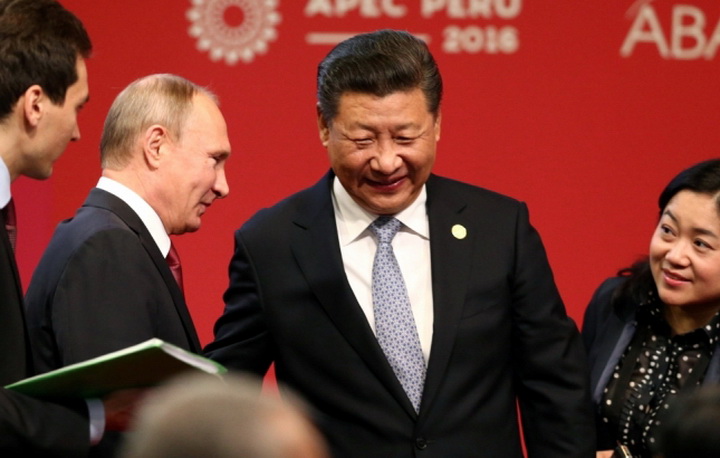
The almost 25-year-old North American Free Trade Agreement (NAFTA) has been relegated to the dustbin of history. The United States, Canada, and Mexico have agreed on a trilateral trade deal — the United States-Mexico-Canada Agreement (USMCA) — to replace it.
As expected, the agreement finalized on Sept. 30 is intended to stimulate production in North America and deter outsourcing to low-wage countries in Asia. Imports from other states are being penalized.
The timing is perfect. Now President Trump can tout the USMCA as a win just as the November midterm elections are drawing near.
The USMCA contains a special clause that gives Washington a near-veto over any attempt by Canada or Mexico to make deals with China.
It stipulates that if one of the three were to sign a free-trade agreement with a non-market country, either of the other two would have the right to terminate the trilateral USMCA with six months’ notice and form its own bilateral deal on the same terms.
As a result, Canada and Mexico cannot act as back channels to ship products tariff-free to the United States. The US and the EU have not recognized China as a free-market economy. Neither has the WTO.
This is a major threat to Beijing’s position within the global trading system. China is Canada’s second-largest trading partner and Canada is China’s 13th largest. What this agreement actually is is a forerunner to an economic and trade alliance created in opposition to Beijing.
Once it takes effect after being approved by parliaments and Congress, the USMCA will be the first step in an anti-Chinese global campaign, to be followed by other deals aimed at the same goal.
Evidently the US is going to insist that a similar clause be inserted into other trade accords, particularly the ones being negotiated with the EU and Japan, plus the one it is trying to develop with other nations of Asia-Pacific region.
There is a link between the USMCA and the EU. The Comprehensive Economic and Trade Agreement (CETA), a free-trade pact between Canada and the European Union, came into force a year ago, eliminating 98% of the tariffs between the two parties.
In July, the US and the EU agreed to a ceasefire. President Trump and the European Commission head, Jean-Claude Juncker, agreed to avoid an all-out war and to open up talks on tariffs instead. But that process might falter.
In March, Canada along with major US allies like Japan and Australia, signed a broad trade deal that includes 11 Asia-Pacific nations.
The Comprehensive and Progressive Agreement for Trans-Pacific Partnership (CPTPP) drastically lowers tariffs and establishes sweeping new trade rules. Agreement was reached after President Trump pulled the US out of the Trans-Pacific Partnership (TPP) soon after his inauguration.
The TPP was conceived from the start as a counterweight to China, so the US might join “with a little help from its friends,” such as Canada and Mexico, both parties to the CPTPP. If it does, the CPTPP will inevitably exert great influence on China and become part of the global anti-Beijing campaign.
Japan, a party to the CPTTP, signed a trade deal with the EU in July. It excludes the US and China. A trade deal between the United Kingdom and the United States is moving forward, although it’s hard to predict when it might be completed.
The US is expected to eventually become part of all the agreements excluding China that are listed above, on the condition that they include a “non-market countries” clause. It would please the US if this same provision designed to isolate China were included in other US negotiations with the European Union and Japan.
The war is on, and international trade is the domain.
China is engaged in talks on the Regional Comprehensive Economic Partnership, which consists of 14 countries in Asia and Australasia and excludes the US, but looks like that still has a long way to go. Beijing is also part of the China-ASEAN Free Trade Area (CAFTA) that was established in 2010.
China has free-trade agreements in place with Australia, Chile, Peru, and New Zealand. But that’s not enough to counter the economic offensive being launched by the US. All those partners are largely dependent on America. When it comes to trade wars, they certainly can’t be viewed as China’s loyal comrades-in arms.
Under the circumstances, integration with the Eurasian Economic Union (EEU) is a promising project. That Union is made up of Russia, Belarus, Kazakhstan, Armenia, and Kyrgyzstan. They control 3.2% ($2.2 trillion) of global GDP.
If signed, a free-trade agreement would meet the goals of China’s Belt and Road Initiative (BRI). Nearly 40 countries, including India, Singapore, and Turkey, have expressed their readiness to begin negotiations on free-trade agreements with the EEU or have already entered them.
Russia and China are natural allies. The BRI and Russia’s pivot toward Asia complement each other.
The modernization of the Trans-Siberian Railway and the project to construct high-speed highways inside Russia, including the construction of a railway line traveling through Kazakhstan to northwestern China, look very promising, creating a link between Russia, the countries of Central Asia, China, and Europe.
Actually, a first step in this direction has already been taken. In May, the EEU and China signed a trade and economic agreement. The deal simplified certain procedures but it did not eliminate duties and non-tariff barriers. But marked the first institutional deal between the two entities on economic and trade cooperation.
Russia and China are in the same boat, as they have found themselves the targets of US attacks. It’s only natural for them to integrate economically. The more the US tries to reshape the world, the more resistance that policy will meet, as other nations are pushed closer together, expediting the emergence of a multipolar world.
ARKADY SAVITSKY | SCF
The article was originally published by Strategic Culture Foundation
The 21st Century
